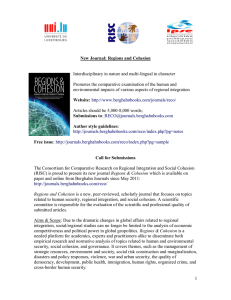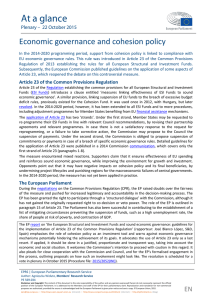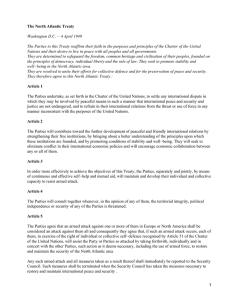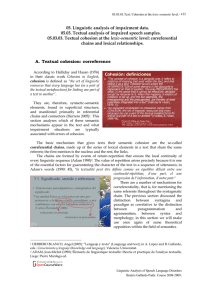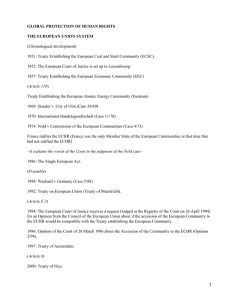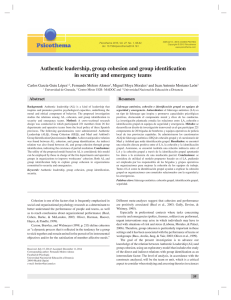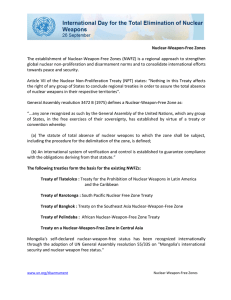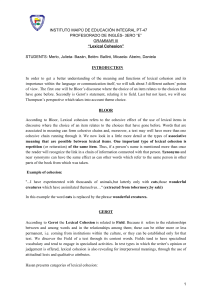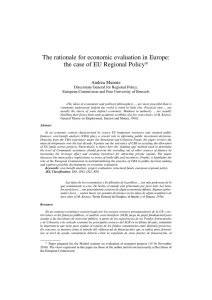Tasks, policies and competences of the European Union
Anuncio
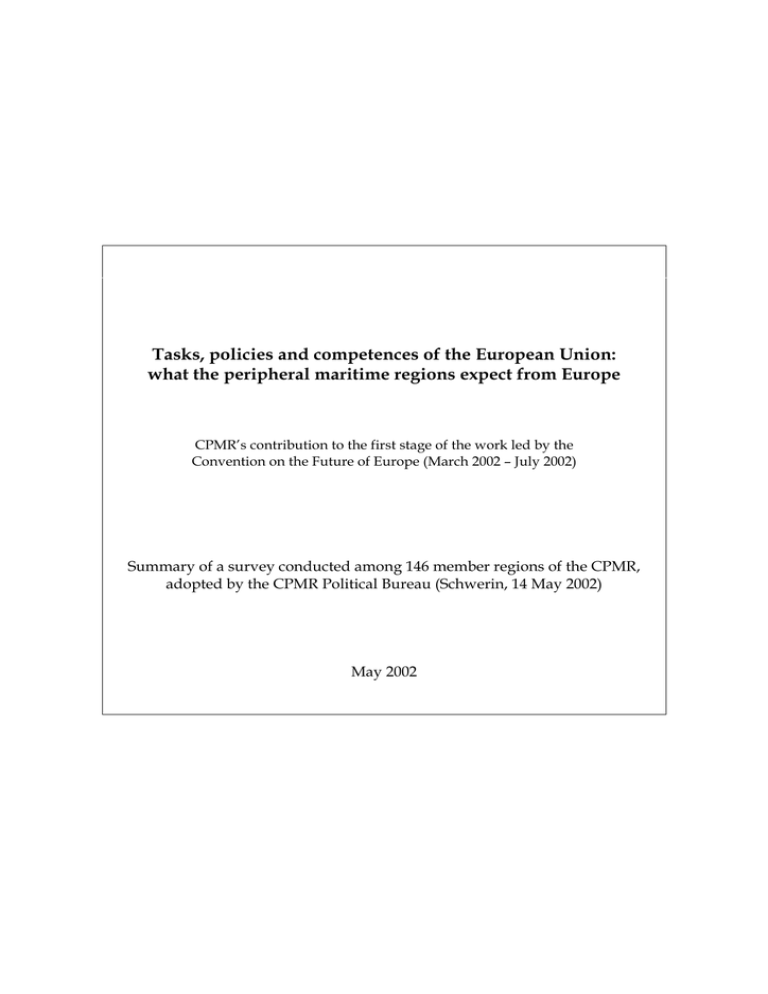
Tasks, policies and competences of the European Union: what the peripheral maritime regions expect from Europe CPMR’s contribution to the first stage of the work led by the Convention on the Future of Europe (March 2002 – July 2002) Summary of a survey conducted among 146 member regions of the CPMR, adopted by the CPMR Political Bureau (Schwerin, 14 May 2002) May 2002 INTRODUCTORY REMARKS The survey sent out by the CPMR to its 145 member regions falls within the context of the first stage of the work led by the Convention, which consists in defining what Europeans expect from the EU over the next thirty years. Through the Convention’s 105 members, this debate involves all levels of democratic representation, including the regional level via the Committee of the Regions. In most States, the local and regional authorities have wide-ranging or more restricted legislative or executive powers, and are thereby directly involved in implementing EU policies and legislation. This is a statement of fact that was endorsed in the Laeken Declaration. They therefore have responsibilities towards the European Union and on this account have wished to express their expectations with regard to Europe as part of the debate on the future of the EU, which is due to result in a revision of the Treaties in 2004. The proposed questionnaire has not taken up on all the questions raised in the Laeken Declaration. It has been designed to raise specific issues for consideration regarding the fundamental tasks and priorities of the enlarged Union, the resulting policies and the division of powers best adapted to this new set-up, with a particular clarification as to what place should be given to the regional level within the European institutional system. These are among the issues to be addressed during the Convention’s first two working sessions focusing on: - What tasks should the EU pursue and what Community policies should be implemented to achieve these objectives? How should they be fulfilled and through what kind of system of division of powers within the EU? On the basis of the 60 replies received, the CPMR is submitting to the members of the Convention the attached summary, which it hopes will reflect as accurately as possible the full range of suggestions and proposals put forward by regions from: - 10 Member States (Denmark, Finland, France, Germany, Greece, Italy, Portugal, Spain, Sweden, United Kingdom), 5 applicant countries (Estonia, Latvia, Lithuania, Romania, Turkey), one third country (Norway). These replies also express the point of view of the geographical areas to which these regions belong, i.e. Mediterranean, Atlantic, North Sea, Baltic, Islands, Balkans and Black Sea. ************** 2 I. 1. THE TASKS OF THE ENLARGED UNION OVER THE NEXT THIRTY YEARS A dual mission for the EU at home and abroad 1.1 The regions consider that the initial key to ensuring the success of the enlargement and deepening of the Union is to redefine the European project in line with the new challenges that Europe will be facing in the coming years. Regardless of whether they belong to EU Member States, applicant countries or third countries, the regions share a common conception of the role that they wish to see the EU play in the years to come. The majority of them underline that the EU should progress towards two main aims, which should constitute its basic future tasks: - within the EU, ensure peace between Member States by further developing its model of pacific organisation. This principal aim of the construction of Europe should continue to remain the basis for European integration. The regions are in favour of completing the economic integration of the EU, provided that it serves to promote not only economic but also social progress, by ensuring a Europe-wide economic, social and “territorial” cohesion. They regard the EU as an area that fosters development and solidarity, in which the single market and single monetary unit should serve as instruments. The EU should also become a model area for sustainable development and a centre of excellence for knowledge and education. There also emerges a will to press ahead with the political integration of the Union. The regions wish to see the development of a strong political Union that is capable of guaranteeing the diversity of the identities of its constituent nations and peoples, rather than creating a uniform and standardised area. - outside the EU, rise to the challenges of the 21st century that the regions consider to be of an environmental and geopolitical nature. The regions are therefore in favour of a “European Power” capable of playing a greater role in world affairs and which is not inward-looking. It should be able to affirm its identity on the international scene in order to promote the balanced, sustainable, supportive and peaceful development of the planet. Its economic and demographic weight and the richness of its civilisation put it in a privileged position to defend this conception of development on a worldwide scale. It should therefore seek to promote – in a more emphatic way than it has done so far– a better global governance, based on multilateralism and a set of globally common rules for the organisation of trade, circulation of capital or development. World governance should no longer be simply a matter for international organisations. It should also affirm its identity on the international scene to contribute towards stability and peace, particularly on its external borders in the Mediterranean, around the islands and along its northern borders. Fostering transnational, cross-border and interregional cooperation should also be considered as a priority. 1.2 The regions consider that the above constitute the two main priority tasks of the European project, an opinion also expressed by the citizens during the consultations on the future of Europe that were led in a number of Member States in preparation for the European Council in Laeken. These two aims are considered to be the main conditions for success with regard to the enlargement and deepening of the EU and should serve as guiding principles for future EU action. 3 The replies also show that whatever their geographical location and political affiliation, the regions share common values which constitute for them the basis of a European identity: democracy, freedom, solidarity, diversity, respect for human rights, rule of law, social market economy and sustainable development. 2. The EU’s internal mission: a priority for the regions – strengthening the internal economic, social and territorial cohesion of the EU 2.1 For most of the regions, this twofold vision of the EU’s role is already conveyed through the current Treaties. The objectives defined in Article 2 of the Treaty establishing the European Community correspond to the conception that they have of the enlarged Europe and how it will evolve over the coming years. Nevertheless, they deem that these objectives have only partly been attained or accomplished and should consequently continue to be included as part of the EU’s tasks, which will be set out in the forthcoming Treaty. Rather than being extended or restricted, these tasks should instead be defined in more detail by determining new priorities depending on the results already obtained. The regions therefore want the members of the Convention to discuss what they consider has already been achieved or is in the process of being finalised from among the objectives set by the founders, in order to be able to define the next steps forward. 2.2 Regarding the EU’s internal mission, as far as the regions are concerned, they consider that it is in the field of economic integration, particularly through the single currency and the achievement of the internal market, that the EU has made the most progress; a stage that they deem is just about completed. Europe should now start to head towards a greater balance between the economic, social and political dimensions. The next stage should therefore consist in strengthening the internal cohesion – both economic and social – of this great market. After almost twenty years spent completing the internal market, it is imperative according to the regions to follow on from this achievement by getting this second stage underway and making it one of the EU’s top priorities for the coming years. There can be no political dimension without a sufficient degree of internal cohesion. We only need refer to the many analyses to emerge from economic and academic circles to note that there is no lack of grounds in support of this argument. The European Commission has itself also recently shown, through its second cohesion report, the steps that still need to be taken to ensure the internal cohesion of the European area; a vision largely shared by the European Parliament, the Committee of the Regions and the Economic and Social Committee. Directly linked to the realities on the ground, the regions are inclined to uphold these orientations. They do in fact point out that although some progress has been made to reduce the disparities in Europe, the gaps are still very wide. This is just as true within individual Member States themselves as between Member States as a whole. These imbalances are set to increase in the light of the future challenges that the EU will have to face, i.e.: - - on the one hand, the enlargement of the Union to the east, which will introduce greater diversity into the economic, social and cultural fields, something that is especially highlighted by the applicant countries, on the other hand, the ever growing trends towards the geographical concentration of activities and people related to a search for increased economies of scale, and therefore towards markets big enough to provide a better match between skills and jobs, easier access to social amenities in urban areas, etc. 2.3 However it is above all at regional level that these disparities are most acutely felt. The challenges will also need to focus therefore on the growing fracture between territories; gaps that have continued to widen over the past few years for want of a sufficiently strong political 4 will coordinated between the EU, the States and the sub-state levels. These challenges demand actions in favour of “territorial cohesion”, which the regions believe is a consequence of economic and social cohesion that the EU can no longer continue to ignore. The revision of the Treaties offers the opportunity to remedy this major shortcoming of the European project by entrusting the EU with this new task. The inclusion of “territorial cohesion” as one of the aims of the enlarged Union, which would commit the EU to undertaking all the necessary action to reduce the gaps in the levels of development of the regions, also complies with a need for consistency and clarity in the forthcoming Treaty: - although “territorial cohesion” does not appear among the current objectives of the Treaty, it nevertheless serves as the basis for Article 16 of the TEC concerning services of general economic interest. It has to be accepted, in the light of the recent positions expressed by the European Council in Barcelona and the complete change of judicial attitude by the Court of Justice, that this will be an increasingly important reference in the process of opening up the markets and in the development of EU policies, in order to guarantee universal service which is a condition for cohesion, solidarity and equality between citizens and the territories in which they live, - similarly, the economic and social cohesion policy (Title XVII of the TEC, Article 158) refers to the notion of the overall harmonious development of the Community, although it does not plainly state an actual objective of “territorial cohesion”. Article 2 of the TEC also calls for a balanced competitiveness with the European Area. The regions are now wondering what justification certain States and the European institutions can give for not adding the objective of “territorial cohesion” to the objective of economic and social cohesion pursued by the EU. It would nonetheless help to meet the citizens’ demands for transparency and legibility and give greater coherence to the new constituting Treaty. The inclusion of this objective would also correspond to the need to see all EU sectoral policies contributing towards reducing territorial disparities and give the necessary impetus to improve the coherence and coordination between the policies accompanying the internal market. 3. Moves towards a European citizenship 3.1 It is pointed out that if the EU is to accomplish its tasks as defined above, there also needs to be a greater sense of belonging to a Community of values and therefore a move towards appropriating the notion of European citizenship. A number of regions indicate that the introduction of the Charter of Fundamental Rights into the Treaty, which establishes the rights and common values of Europe’s citizens, would be a first step in this direction. 5 II. EU POLICIES 1. Towards policies adapted to the EU’s tasks 1.1 The regions underline that the priority objectives they wish to see pursued by the EU may only be achieved through a series of ambitious common internal and external EU policies, most of which they consider to be already included in the Treaty and implemented to a more or less satisfactory degree. 1.2 Nevertheless, they consider that it is necessary to strengthen the role and action of the EU in certain fields, such as: - external and defence policies, immigration policies, checks at external borders, fight against crime and terrorism, international trade, monetary and fiscal policy, regional and cohesion policy, accompanying policies for the internal market: competition, taxation, agriculture, transport, etc., social policy, environmental protection. It should be noted that positions differ slightly with regard to some areas. This is the case for security and defence, which according to certain regions in northern Europe and the applicant countries should remain within the remit of the States1, while most of the regions from southern Europe are in favour of strengthening the role of the EU in this area. The same is true for taxation, education and training, justice and health and social welfare, where the regions do not hold a unanimous view on whether intervention should be led exclusively by the States or shared between the EU and the States. The regions are, as a majority, against the idea of restoring certain EU policies to the Member States, with the exception of four of them which consider that full or partial re-nationalisation of the regional and agricultural policies would better correspond to the national constitutional order of the federal States in particular, where these matters fall within the remit of regional government. For the great majority, re-nationalisation in these sectors would undermine the very purpose of the EU, which is to ensure the solidarity and internal cohesion of its area, a role the States are unable to assume separately. A single market has no other choice but to justify maintaining a common policy, rather than 15 uncoordinated policies. 1.3 However, the regions underline above all that most of the EU’s competences cannot easily be exercised exclusively (apart from external trade policy, marine resources management and monetary policy) and require a coordinated joint intervention by the EU, the States and also the regions. This is the case in particular for the regional and cohesion policies, the accompanying policies for the internal market and even, as some also mention, foreign and defence policy. 1.4 The regions deem that the EU’s role and action should not only be strengthened, but should also take effect differently and be adapted according to new social, economic, ecological and territorial requirements. Reforms are necessary in the light of the following observations: - 1 Today there is an inconsistency between the missions of the EU as defined in the treaties and the way in which they are translated through certain common policies. Sectoral policies for example make little or no contribution towards the objective of economic and social cohesion, which from the regions’ point of view ought to constitute one of the main priorities of the enlarged Union. The rationale behind the sectoral policies accompanying This position reflects the historical traditions of neutrality in this particular area in certain northern European States. 6 the single market is primarily dictated by economic performance, financial returns or excellence, rather than by equity or territorial cohesion. The notion of a balanced development between Europe’s territories is only taken into account in the principles of application of the regional and cohesion policy and is still lacking from almost all EU sectoral policies. - Furthermore, the regions feel that there is a lack of horizontal coherence between the various EU policies, which are simply juxtaposed to one another, whereas they generally ought to be better coordinated in order to maximise their impact, - This same lack of coordination between the objectives pursued by the different EU sectoral policies can also be observed between EU policies and the policies conducted at national and regional level, - The action led by the EU through its policies is considered to be too dogmatic. This is especially the case of agricultural, transport and environmental policies. The role of the EU ought to evolve. What these sectors need is drive, coordination and frameworking rather than excessive rules and regulations, - Finally, the regions point out that EU policies lack flexibility and are becoming less and less adapted to the different realities of the European Area; this need will become increasingly important in the coming years, on account of the speeding up of the decentralisation process and above all of the effects of globalisation that require solutions as close to the ground as possible. 1.5 There is the risk that this gap will widen further unless policies are redefined on the basis of the new priorities that are expected from the enlarged Union. Although the regions consider that these observations are equally valid for both internal and external EU policies, they have wished to suggest proposals for reforming the policies accompanying the internal market which they deal with directly in the exercise of their responsibilities and whose impact on the territories is most apparent. These include: 2. regional policy, competition policy, transport policy, research policy, education and training policy, common agricultural policy, environmental policy, Proposed reforms of the policies accompanying the internal market: adapting them to the missions and improving their efficiency and the way they work 2.1 The chapters defining the policies accompanying the internal market should follow a standard plan, which would require a harmonisation of the provisions of the new Treaty. For each of the policies, the regions would like to see defined: - the mission(s) of the EU towards which they contribute, the content, the instruments for implementation, the degree of flexibility necessary to ensure a satisfactory application of the policy in accordance with the required impact, coordination with the other EU policies, - the responsibility of the various public-sector players: EU, States and Regions, the decision-making process applied, the partners consulted in the definition and implementation of the policy. - 7 2.2 By way of an example, the regions have drawn up a diagnosis of a number of policies and proposed adaptations or reforms, the details of which will be set out in a forthcoming document. The table below proposes an initial summary: POLICIES ADAPTATIONS Economic, social and “territorial” cohesion Competition (regional State aids and special tax arrangements) - Make the policy relate more to the objective of economic, social and “territorial” cohesion, - Competences: current distribution adequate - Implementation: need for greater flexibility - Greater coordination with the regional and cohesion policy and policies accompanying the internal market, - Consultation of the regions necessary - Contribute towards the objective of cohesion: need to add a territorial dimension to the rationale behind market regulations, - Competences: the EU ought to play a greater role, even though this policy should remain shared between the different levels, - Consultation and involvement of the regions is necessary. Transport Research and innovation Education and training Agriculture Environment REFORMS - Continue to contribute towards the objective of cohesion and competitiveness, - Competence: should remain shared between the EU, the States and the Regions and progress towards a genuine European territorial policy (European reference framework) Implementation: should become an instrument to support the development of all the regions - Greater coordination with the other policies - Consultations: need for greater involvement of the regional level - Take greater account of the territorial and cohesion dimensions, - In favour of new tools: tripartite contracts between the EU, States and Regions - Competences: the EU ought to play a greater role even though this policy should remain shared between the different levels. - Consultation and involvement of the regions is necessary - Contribute towards the objective of economic and social progress, - Competences: current distribution adequate - Implementation: need for greater flexibility - Greater coordination with the regional policy - Consultation of the regional level necessary . - Participate towards the objective of cohesion by focusing on new aims: rural development, environment, quality, etc. - Competence: should remain a priority area of action for the EU - Implementation: adapt to the specificities of the territories - Coordination with the regional policy required - Contribute towards the objective of sustainable development - Competences: current distribution adequate - Implementation: readapt the overly prescriptive interventions by the EU, need for greater flexibility - Greater coordination with all other policies 8 III. THE EXERCISE OF POWERS AND THE PLACE OF THE REGIONS IN THE EUROPEAN INSTITUTIONAL SYSTEM 1. Principles to be clarified in the Treaty 1.1 For the regions, the EU will be unable to exercise its duties in the appropriate manner unless there is a reform of the way in which public powers are organised in Europe and of their mode of governance. They point out that the current debate should not focus solely on the new structure of the institutions that would be adapted to an enlarged Union, but also on the coordination between the different levels of government. The challenge of the current reform is to succeed in introducing coherence and a greater coordination between the EU’s role and the way its institutions operate, and the role of the States and the Regions. They therefore consider that the new Treaty needs to explicitly acknowledge this statement of fact, brought about by the change in the economic, societal and international contexts of the past few years. The Union of the next thirty years cannot work as it has done up to now, by simply juxtaposing policies to those already led by the States and regions for want of a framework for coordination and consultation on the way in which the different public-sector actions can contribute towards achieving the objectives of the EU as defined in the Treaties. 1.2 The regions make the following diagnosis: - - - the powers attributed to the EU have been accumulated with no identifiable principle of accountability, the principle of the “implicit powers” of the Union, set out in Article 308 and which has allowed the EU to increase its scope of intervention, is not accompanied by a transparent and efficient control mechanism, the system for attributing powers is not clearly defined, nor, even, is a clear distinction made between exclusive competence and competence that is shared between the Union and the States, the principle of subsidiarity and its protocol annexed to the Treaty are unclear, making its application and monitoring difficult, the sub-state levels are not mentioned in the Treaty, despite the fact that in their capacity as public players they are involved in the application of many EU regulations, the articles are scattered throughout the Treaties and the powers of the Union are described differently from one policy area to another, 1.3 Consequently, they suggest that clearer and more legible principles and definitions be laid down in the Treaty – which would also correspond to an explicit demand on the part of the citizens – and state their support for the following options: - The functional method of attributing powers is preferred by the large majority of regions, since it guarantees a certain flexibility for European integration. They are therefore in favour of the EU’s competences being attributed in accordance with the tasks it has to accomplish. However, they consider that it is necessary also to define the main policies that fall within the scope of the EU’s missions, and to list them in the Treaty by way of illustration, while at the same time avoiding a line of reasoning by which areas of exclusive competence would be compartmentalised. A minority of regions with legislative powers express an opinion in favour of the material method, similar to that applied in the federal systems, whereby the areas of intervention of the EU and States should be defined in greater detail by subject. This has the advantage of being clearer and of avoiding an unjustified increase in EU interventions. 9 - The regions also deem that it is necessary to define the criteria for attributing powers to the EU, which is a condition governing the application of the functional method. They all consider that the criterion for justifying the exclusive action of the EU should be the transnational nature of the action. They also point out that certain criteria such as solidarity and cohesion requiring coordination actions that the EU alone is able to provide should also be able to serve as grounds for Community intervention. With regard to shared competences, which represent the greater number, most of the regions feel that the principle of subsidiarity should be maintained, which states that “the Union shall take action, in accordance with the principle of subsidiarity, only if and insofar as the objectives of the proposed action cannot be sufficiently achieved by the Member States and can therefore, by reason of the scale or effects of the proposed action, be better achieved by the Community”. - However, they underline that a permanent regulation and control mechanism for subsidiarity should be applied to prevent the Union from extending its powers, while at the same time preserving the European dynamic. This monitoring function should be provided: - for most of the regions, by political mechanisms, and fall within the remit of the European Parliament and national parliaments, or even the Committee of the Regions and/or the Council of Ministers, - for a minority, by legal mechanisms through the intervention of the Court of Justice. Some regions however point out that these mechanisms and principles are already provided for in the Treaty, and it is simply a question of the institutions applying them more effectively and earnestly. The principle of subsidiarity has been used more as a rhetorical reference than as a concrete reference for institutions in the exercise of their powers. - 2. They also feel that the distribution of tasks cannot be set rigidly in time and that this needs to be adapted at regular intervals and therefore remain open to future changes. An update and a general assessment every 10 years is one of the options proposed, since this would help to take into account the increasingly significant transnational impact of activities, which justifies the EU’s intervention in areas where it was not necessarily needed before (education/mobility, environment, food safety, etc.). The role of the regional level in the European institutional system 2.1 The regions feel that it is indispensable for these principles to be not only clarified but also broadened to take into account the regional level. The EU cannot continue to ignore the extent of the decentralisation processes in most of the Member States, which are leading the regional level to become increasingly involved as an institutional player in matters not just of national concern but also in European and world affairs, and whose demographic and economic weight may at times exceed that of certain States. This tendency is not without consequences on the way in which the States involve their local and regional authorities in the preparation and implementation of EU policies. The experience of the highly regionalised and decentralised States also shows that the exercise of certain EU powers requires forms of cooperation not only with the national administrations but also with the regions. The regions point out that although the Treaty on the European Union does indeed make several references to the regional level, it does not provide a consistent framework enabling the place and role of the regional level in the European decision-making process to be assessed and clarified. 10 2.2 They therefore would like to see, further to the mandate drawn up in Laeken, the possibility of envisaging a more legible wording of the Treaty that would provide an overview of the status of the sub-state tiers – their responsibilities and their rights – thus providing a clearer response to the expectations of the citizens to whom these levels are directly accountable. In the same way that the role of the national parliaments will be more clearly defined, it is likewise necessary to clarify the responsibilities of the other representative democratic institutions. The regions propose two complementary options that do not bring into question the role of the States, which are and should continue to be the principle players in the EU. - include the regional level in the system of distribution of powers laid down in the new Treaty by broadening the principle of subsidiarity to include the relation between the EU, the States and the Regions. This would not undermine the right of each Member State to structure its domestic territorial organisation as it sees fit. - acknowledge local and regional democracy as a common asset to all the EU States in the principles of the new Treaty, and define on this basis a status for the regions and the general principles for involving them in the management and implementation of the EU’s internal policies and the decentralised strand of its external policies. This status will be implemented in line with the different national constitutional realities, but it should also be subject to an open coordination procedure that would allow the States to discuss the assessment of its application and to measure the effects thereof. The regions consider that the proposal put forward by the European Parliament for a status of “regions - partners of the Union” is an interesting idea that they would urge the members of the Convention to examine. 3. A more democratic way of working 3.1 While the regions give little opinion on the reform of the EU’s institutional set-up, they nevertheless insist on the need to improve the democratic working of the EU institutions without undermining the effectiveness of its action, so that the citizens might have greater confidence in the European institutions and their related tasks: - They feel that progress still needs to be made essentially in respect of the European Parliament and the national parliaments. They are in favour of increasing the role of the European Parliament and revising its election procedure (elections on a regional basis in all Member States). They also indicate that the Committee of the Regions ought to be raised to the rank of institution to give it the material and institutional capacity to assume its role as a local interface with the citizens. They consider that the role of these representative institutions should be examined within the framework of a wider debate on the deepening of European grassroots democracy, - A minority is in favour of democratising the European Commission by giving the European Parliament the power to elect the President of the College of Commissioners. 3.2 The regions also underline that the citizens feel far-removed on account of the formalities, bureaucracy, and complexity associated with the way these institutions work. To remedy this, the regions point out that the Union needs not only a reform of the institutional set-up, but also a new way of “governing” by introducing new methods of governance that are more transparent, participative and flexible, with a view to bringing the institutions closer to the citizens. They demand a clear commitment in favour of modernising the European decisionmaking process. For this reason, the regions state that they are in favour of introducing into the Treaty the five principles of good governance upheld in the European Commission’s White Paper – openness, participation, accountability, effectiveness and coherence. 11
